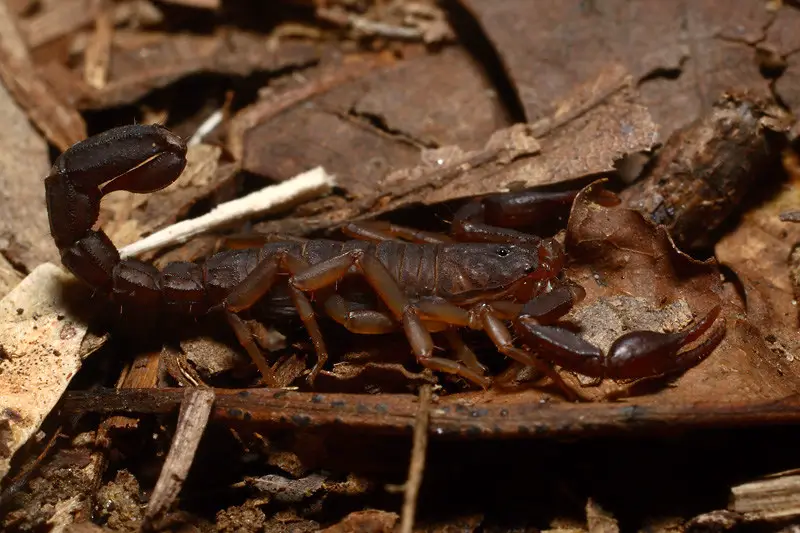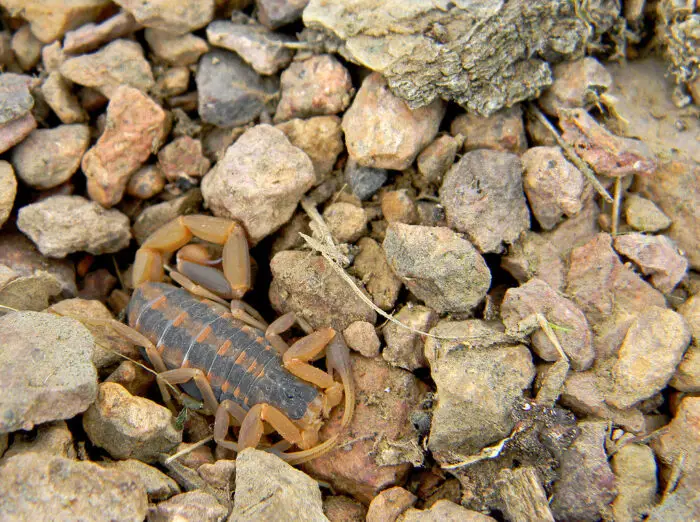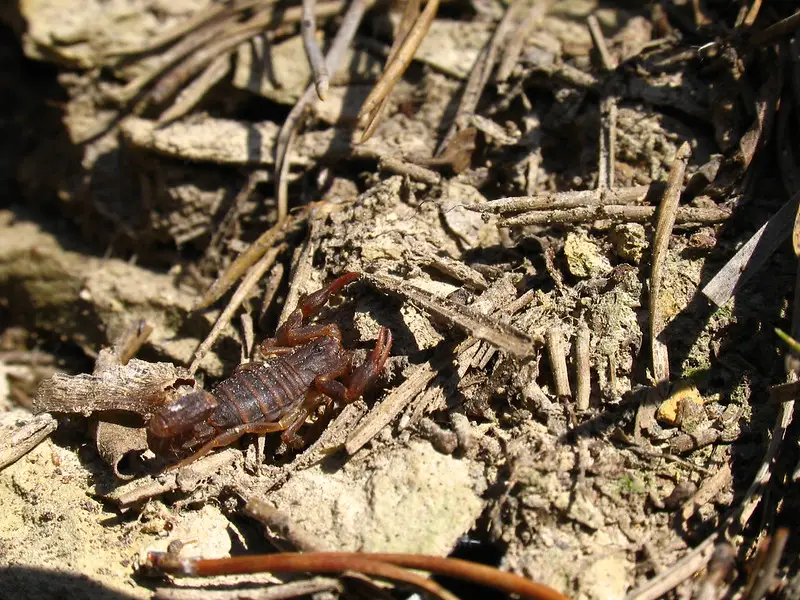Louisiana has 2 true species of scorpions. They are the Striped Bark Scorpion and the Southern Devil Scorpion.
Both Striped Bark Scorpions and Southern Devil Scorpions have stings that are of minor medical importance. In fact, neither of them is more medically significant than a bee sting. However, all scorpion stings have the potential to cause severe allergic reactions such as anaphylactic shock. If you have blurred vision, muscle spasms, or difficulty breathing after experiencing a scorpion sting, seek immediate medical attention.
The Pelican state is also home to small scorpion-like arachnids called pseudoscorpions. We’ll also talk about pseudoscorpions in the paragraphs below.

Southern Devil Scorpion (Vaejovis carolinianus)
People associate scorpions with the dry arid country of the American desert southwest. However, there are also types of scorpions that are native to parts of the moist, humid southeast. The southern devil scorpion is one of these.
This scorpion species, which also has the common name Southern Unstriped Scorpion or Carolina Devil Scorpion, is native to all or parts of North Carolina, South Carolina, Florida, Georgia, Louisiana, Virginia, West Virginia, Alabama, Mississippi, and Kentucky.
According to the Louisiana Department of Wildlife and Fisheries website Southern Devil Scorpions live mainly in the East Gulf Coastal Plain and the Southern Loess Bluff Forest of West Feliciana Parish. See
Although Southern Devil Scorpions pack a painful sting, the venom of this species is not considered to be medically dangerous to normal healthy individuals. People that have been stung by one report that the pain intensity is very similar to a wasp sting.
What do Southern Devil Scorpions look like?
All scorpions look a little bit like tiny land-dwelling lobsters with some distinctions. Lobsters have 10 legs, while scorpions have 8, and of course, lobsters don’t have a bulbous venom-filled stinger on the end of their tail, while scorpions do.
Southern Devil Scorpion adults are about 1.5 inches long and are dark brown in color.
Southern Devil Scorpion Behavior
Just like the Striped Bark Scorpion that we’ll talk about below, Southern Devil Scorpions are nocturnal hunters. During the day, they take shelter in leaf piles, under rocks, in crawl spaces, and beneath wood litter on the forest floor. They are very skittish and would rather hide from you than sting you.
They only use their stinger for defense or to subdue their prey. Their prey, by the way, consists of small insects and arachnids, such as spiders.
Like all scorpions, Southern Devil scorpions have compounds in their exoskeletons that glow under black light. To see them after dark, consider investing in a UV flashlight.

Common Striped Bark Scorpion (Centruroides vittatus)
Striped Bark Scorpions, which also go by the common names Plains Scorpion, Wood Scorpion, or Stripe Backed Scorpion, are Buthid Scorpions, just like the Arizona Bark Scorpion. However, their sting is not nearly as dangerous as that of the Arizona Bark scorpion. Common Striped Bark Scorpions are the most common scorpions in the United States. Thousands of people are stung by them each year when they step on them with bare feet or come into accidental contact with them in some other manner.
Unlike Northern Scorpions and Northern Black Hairy Scorpions, which never venture far from their burrows, Striped Bark Scorpions are wandering hunters. Like all bark scorpions, they are natural climbers. Besides living under rocks, they climb trees and fence posts and have no problem climbing the walls of your home. They actually have a negative geotaxis, or in other words, they prefer an upside-down orientation. See
Striped Bark Scorpions live in a wide variety of habitats, such as woodland, grassland, and desert. During the day, they will take shelter under loose stones, in leaf litter, beneath loose bark, or in wood piles, etcetera.
Like all scorpions, they are nocturnal creatures and will be under shelter until after sundown. What’s more, as all scorpions do, they have fluorescent compounds in their exoskeletons that make them glow under black light.
If you are camping in an area where striped bark scorpions are active, it’s a good idea to go armed with an ultraviolet flashlight. Use the ultraviolet light to scan your campsite after dark. Remember that the darker the night, the more the scorpion will glow. In other words, they are more luminous on a night of a new moon, for example. What’s more, campfires and other sources of light will cut down on the effectiveness of your UV light source. One last thing to remember on this subject is that UV light radiating in the 320 to 400 nm range isn’t overly harmful to your vision. However if you choose to use a light source that produces shorter wavelengths, you’ll want to also use eye protection.
Distributions of the scorpions Centruroides vittatus begin in the northern Mexico states of Chihuahua, Coahuila, Nuevo Leon, and Tamaulipas. It then extends northward up to the southern counties of Nebraska. Their range also extends longitudinally from the Sangre de Cristo mountains and Rio Grande of New Mexico in the west and the Missouri River and the Mississippi River in the east. The following U.S. states have populations of Striped Bark Scorpions: Arkansas, eastern Colorado, Kansas, Illinois, Louisiana, Mississippi, Missouri, Nebraska, New Mexico, Oklahoma, Florida, Georgia, and Texas.
They are the most widely distributed scorpion species in North America.
In areas with colder wintertime temperatures, striped bark scorpions survive by tolerating limited freezing of their body tissue. These scorpions then hibernate through the winter months. In areas with colder climates, these little guys may be more likely to enter houses during the winter months. Be sure to eliminate foundational cracks, weatherstrip any spaces around your doorway and eliminate any other entry points that might allow these creatures easier access to your home.

What do striped bark scorpions look like?
Adult striped bark scorpions are up to 2 3/4″ long. An adult of this species is uniformly brownish yellow in color, with the exception of a distinctive pair of broad dark longitudinal bands that run the length of its back, a triangular median dark spot at the top of its head, and the tip of the stinger which is brown or black.
Striped Bark Scorpion Behavior
Striped Bark Scorpions mate in the fall and also occasionally in spring or early summer. The mating process begins with the male engaging the female scorpion in an elaborate mating dance called the promenade a deux. At this time, the male maneuvers the female to a spot where he can deposit a sperm packet called a spermatophore for her reception.
The male must hold the female over the spermatophore long enough for her to receive it. Therefore, larger males successfully mate a larger percentage of the time. If the female accepts the male’s spermatophore, the pair join together and rub chelicera in the “kiss” stage. At this point, the female takes up the spermatophore. What follows is about an 8-month gestation, after which their offspring are born alive.
After the newborn northern scorpions free themselves from the birth membrane, they will climb up their mother’s walking legs and onto her back. The young scorpions ride there on their mother’s back in a grouped formation, only climbing down to feed on pellets that the female scorpions create for them when she feeds until they are sufficiently old to strike out on their own. This is generally after their first molt. See

Pseudoscorpions in Louisiana
The pseudoscorpion, which is also sometimes called the book scorpion or false scorpion, is a tiny arachnid that looks a lot like a tiny scorpion minus the stinger. They have a flat, pear-shaped body, eight legs, and two long pedipalps with pinchers on the ends, just like scorpions.
People also sometimes mistake these tiny little creatures for ticks. There are over 3,300 pseudoscorpion species worldwide, and their average body length is just 3 millimeters.
Book scorpions don’t have a stinger on their tail. However, they do have a stinger in each pincher. They inject their prey with venom to immobilize it. After which, they secrete a fluid over it to dissolve it so that they can ingest the liquified remains.
Book scorpions are generally beneficial to humans since they prey on pests such as clothes moth larvae, carpet beetle larvae, booklice, ants, mites, and small flies. See
Recent Posts
The only venomous snakes in Washington State are Northern Pacific Rattlesnakes. The Northern Pacific Rattlesnake (Crotalus oreganus oreganus) is a sub-species of the Western Rattlesnake. Anyone...
Skunks are not classified as true hibernators. But they go into a state of torpor when the weather gets cold. Skunks are light sleep hibernators, along with opossums, bears, and raccoons. ...

